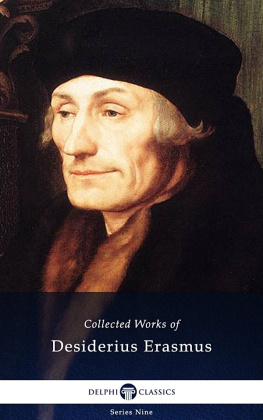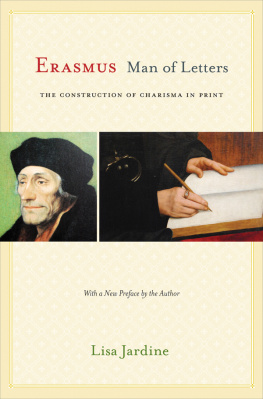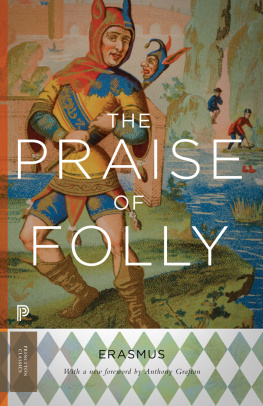ERASMUS AND HIS BOOKS

Egbertus van Gulik
at work in the Leiden University Library in 1981
Courtesy of Klaas Koppe, Amsterdam
Egbertus van Gulik
ERASMUS AND HIS BOOKS
Translated by J.C. Grayson
Edited by James K. McConica and Johannes Trapman

University of Toronto Press 2018
Toronto Buffalo London
utorontopress.com
Printed in Canada
ISBN 978-0-8020-3876-0

Printed on acid-free paper with vegetable-based inks.
Library and Archives Canada Cataloguing in Publication
Gulik, Egbertus van, 19101998, author
Erasmus and his books / Egbertus van Gulik ; translated by
J.C. Grayson ; edited by James K. McConica and Johannes Trapman.
(Erasmus studies)
Manuscripts translated from the Dutch.
Includes bibliographical references and index.
ISBN 978-0-8020-3876-0 (cloth)
1. Erasmus, Desiderius, 1536 Library. 2. Erasmus, Desiderius, 1536 Library Catalogs. 3. Erasmus, Desiderius, 1536 Books and reading.
I. Grayson, J.C. (J. Chris), translator II. McConica, James K. (James Kelsey), editor
III. Trapman, Johannes, editor IV. Title. V. Series: Erasmus studies.
PA8518.G85 2017 199.492 C2017-902440-X
University of Toronto Press acknowledges the financial assistance to its publishing program of the Canada Council for the Arts and the Ontario Arts Council, an agency of the Government of Ontario.

Contents
by James K. McConica
PART ONE
The History and Nature of Erasmus Working Library
1
The Formation and Growth of the Library
2
The Disposal and Replacement of Books
3
The Housing and Arrangement of the Collection
4
Maintenance and Binding
5
What the Versandliste Does Not Include
6
Erasmus and the Book: The Humanist at Work
7
Conclusion
PART TWO
The Versandliste of Erasmus Library in 1536: An Annotated Catalogue
Foreword
This study came into being through the dedication of a single scholar, Egbertus (Bart) van Gulik, who devoted most of his life to assembling the information it contains. It provides the most comprehensive evidence available about the books of Erasmus of Rotterdam the books he owned and his attitude towards them, when and how he acquired them, how he housed, used, and cared for them, and how, from time to time, he disposed of them.
Part 1, originally intended by the author to be a separate monograph, tells that story. It also opens the door to a new understanding of the more intimate side of Erasmus daily life as a scholar at home with his books, friends, publishers, and booksellers. Van Guliks lifelong familiarity with the humanist community known to Erasmus makes of his insights a fresh and engaging introduction to the impact of Italian humanism on the more expressly Christian world of northern Europe. Part 2 is a catalogue, a carefully annotated description of all of the items contained in an inventory that was composed after Erasmus death in July 1536. Here we find more than 400 books (some containing several works bound together) that belonged to him. They were shipped from Basel by Erasmus executors around Christmas of that year and consigned to the Polish nobleman Jan aski, following the terms of an agreement made with Erasmus in 1525. aski acknowledged their receipt in early April 1537. That inventory, cryptic and highly abbreviated in form, is known as the Versandliste (shipping invoice). It is the most comprehensive list surviving of the books in Erasmus possession at any given time, here fleshed out for the first time by van Gulik. He drew upon his command of bibliographical data and his extensive knowledge of Erasmus correspondence and related records to propose as precise an identification of each of the titles as the evidence will allow. Van Guliks annotated catalogue, along with the appendixes, which tell us what can be known of other books in Erasmus working library and how he used them, will be of interest to students of the northern Renaissance, the history of the book, and the history of learning.
Egbertus van Gulik
Bart van Gulik was born in 1910 in the small provincial town of Hoorn on the Zuiderzee, where he also received his schooling, supplemented with private lessons in the classical languages. Following the death of his father in 1925 and of his older brother two years later, he and his mother moved to Leiden, where he entered the university in 1929. He first came into contact with the work of Erasmus while attending the lectures of Johan Huizinga, and in 1933 he took his first degree. His painstaking perfectionism prolonged his university studies, which concluded only in November 1941 with his doctoraal (masters) degree. At that point a proposed doctorate with a dissertation Jeffersons View of Europe had to be abandoned. The German occupiers closed the university at Leiden after a student strike, provoked by a now-famous address on 26 November 1940 by the dean of the Law School, Professor Rudolph Pabus Cleveringa, protesting the dismissal of Jewish colleagues. With the assistance of his teachers van Gulik managed eventually to secure a training position in the library of the Peace Palace at The Hague, where his work on a detailed bibliography of the works of Hugo Grotius gave him his first experience of the techniques of bibliography. When, in 1950, the 700-page Bibliographie des crits imprims de Hugo Grotius was published, van Guliks name appeared in the Foreword along with those of the compilers.
In 1942, on the recommendation of Huizinga, van Gulik applied for a place in the University Library at Leiden. After a year of further training there his prospects were such that in the spring of 1943 he was able to marry Tonny van Beusekom, who, like him, had been a member of the literary society Sodalicium Literis Sacrum (a society consecrated to letters) in the university; she eventually taught Dutch at Amsterdam. By the end of the war, German police were searching everywhere for able-bodied men to supply forced labour for the Third Reich, and near-starvation conditions prevailed throughout the country. Nevertheless Bart and Tonny van Gulik survived, and in 1946, four years after joining the library, he was made Keeper of Printed Books. In October 1960 Leiden University appointed him scholarly officer responsible for bibliographical documentation in the field of general history.
In 1961 van Gulik was placed in charge of the City Library of Rotterdam, a central library with ten branches and childrens libraries, and four lending departments. Within its holdings of some half-million books was the largest assemblage of Erasmiana in the world. His predecessor in the post was Cornelis Reedijk, a classical scholar and one of the original promoters of a new, critical edition of the works of Erasmus. The edition was launched by the Royal Dutch Academy (Royal Netherlands Academy of Arts and Sciences) in 1963. Van Gulik, by now an expert bibliographer, started to assemble a bibliography of printed editions of Erasmus in support of the project in the following year. It grew in time to cover the holdings of nearly 600 libraries. In 1969, to mark the publication of the first volume of the critical edition, a three-day international congress was held in Rotterdam, which included a great exhibition in the Boymans-van Beuningen Museum. Van Gulik was largely instrumental in the creation of this exhibition and its invaluable two-volume catalogue,
Next page













